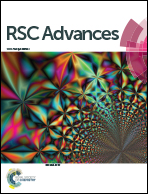Improvement on optical modulation and stability of the NiO based electrochromic devices by nanocrystalline modified nanocomb hybrid structure
Abstract
Among the explored materials for electrochromic devices (ECDs), nickel oxide thin films have been widely applied as an optical anodic layer due to its ability to adjust the optical properties by ion exchange. Generally, to realize the three important characters including color contrast, switch speed and cycling durability, it requires the electrochromic layer to possess different microstructures or crystalline properties. Thus there is still difficulty in designing a suitable structure for NiO film to have excellent electrochromic performance. Here, a nanocrystalline modified nanocomb novel NiO structure is prepared by a simple chemical process. This novel microstructure shows highly multiple channels, high surface areas and good crystallinity. All of these characters produce a good electrochromic performance including fast switch speed (around 2 s), high color contrast (69.4%) and in company with good cycling durability (more than 1000 cycles). This simple chemical process demonstrated here could be suitable for the large scale production of future electrochromic device applications.


 Please wait while we load your content...
Please wait while we load your content...